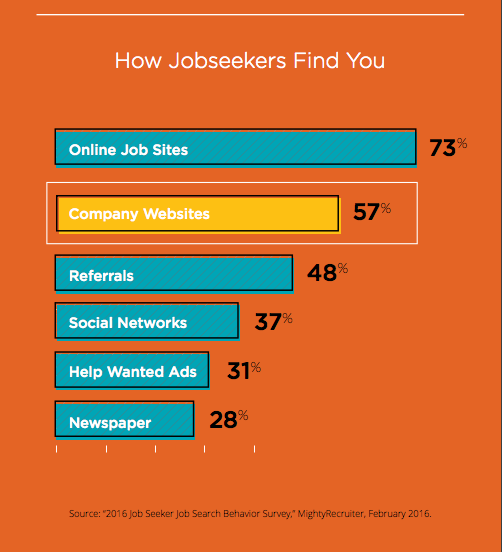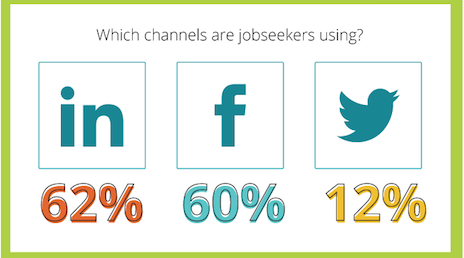Hiring’s never been a walk in the park, but these days, it may be more of an uphill battle than ever before.
Business leaders list finding and hiring talent as their top challenge, there are more job openings today than in 15 years, and recruiters and hiring managers are facing a talent pool with increased expectations and mobility.
Not to mention, even though the vast majority of workers are open to new career opportunities, most of them aren’t actively looking for new roles. These passive jobseekers represent 75 percent of the talent pool today (though 58 percent of them admit to looking at jobs at least every month).
With all of this in mind, it should go without saying: for recruiters and hiring leaders seeking to attract the best, most qualified talent, it’s more important than ever to develop an integrated candidate sourcing strategy that connects with both active and passive jobseekers on as many channels as possible.
Speaking of which, candidates use an average of 17.7 different types of resources when conducting a job search. Some of the channels used most often by jobseekers include:

Your job posting strategy plays an integral role in facilitating this goal, and when it comes down to it, a comprehensive job posting approach that enables you to cover all of the different bases consists of five pillars.
1. Free Posting
Job boards remain the number one place to start, with 73 percent of jobseekers using job boards when searching for jobs. Begin with free postings. Here, you can reach a massive audience at no cost by posting to the 20 or so free job boards and the thousands of others that offer a combination of free and paid postings.
There are two “don’ts” to remember when it comes to free postings:
- Don’t get lost in the crowd. Free postings are massive in number. Your posting needs to stand out from the rest with a job description that sells the unique attributes of the role as well as why your company is the place to work. In particular, as jobseekers care as much about the role as the company, make sure to showcase your company culture, engaged employees, and even delighted customers in the job description and with embedded links to videos, blog posts, and other webpages that do.
- Don’t limit your results. Free posting is just the minimum when looking for a candidate. You’re just scratching the surface and limiting yourself in terms of quality and quantity of candidates.
2. Paid Posting
Paid job postings produce better and faster results than free job postings. Failing to leverage the thousands of job boards with paid postings dramatically reduces your likelihood of finding and hiring the right worker.
There are a couple things that you need to know when it comes to paid job postings.
First, paid postings consist of generalist job boards and niche job boards. Postings on generalist job boards generate more applicants, typically in the range of 11 to 30. Those on niche job boards produce a lower number, normally between 5 and 20, though with candidates that are good fits.

Second, a one-size-fits-all fee model doesn’t exist for paid job postings, as there are four different fee structures that each have their own pros and cons: 1) flat rate, 2) pay per click, 3) pay per application, and 4) pay per placement (once hired).
With the thousands of job boards that offer paid posting options, selecting the right ones is pivotal. In addition to generalist versus niche job boards and selecting the fee structures that meet your requirements best, the following are a few things to consider:
- Go mobile. The percentage of traffic job boards receive is increasingly from mobile devices. Vetting your job boards and making sure they are mobile friendly and offer a responsive design is important. Think twice before posting to ones that don’t.
- Know the demographics. Knowing the audience of a job board is a requisite when selecting niche job boards. If the demographics don’t match with your candidate persona, then don’t post to it. More simply, you wouldn’t expect a bunch of web developers to apply for a position as a bartender, so don’t post your bartender opening to a tech board.
- Gauge the traffic. How does the job board rank in web traffic as compared to similar job boards? You want those with high traffic volumes and that are gaining in popularity.
3. Social Recruiting
Social networks should be a successful part of your job posting strategy as they offer the opportunity to engage with both active and passive jobseekers at a very low cost.
Thirty-three percent of talent acquisition leaders who use social networks for job postings don’t spend a penny on them.
Not to mention, nearly half report they’ve made successful hires when posting to social media, and 59 percent of those believe social media hires are a higher quality candidate than those made from other sources.
While other social networks are worth exploring, the “Big Three” are requisite tools in your toolbox:
LinkedIn. Sixty-two percent of jobseekers are on LinkedIn, with 71 percent following a company on LinkedIn because they want to work for that company. This means you need to make sure you have a great company page with all of your job postings on it—this is especially important since it is often the first time a jobseeker comes into contact with your company.
Facebook. Almost the same number of jobseekers is on Facebook, and two-thirds of recruiters and hiring leaders use the social network for sourcing candidates. Like your company page on LinkedIn, you need to make sure your career page on Facebook is designed for optimal impact—includes postings for every job and information on what it is like to work at your company.
Twitter. While the percentage of jobseekers on Twitter is only 12 percent, companies are finding candidates on the social network: 52 percent use Twitter today, and the number continues to increase. Make sure you tweet about more than just job postings, including your company and what it’s like to work there. Hashtags in your job posting tweets that are relevant for each job will help ensure that they’re seen by the right jobseekers.

4. Employee Referrals
Employees often are cited as the most effective candidate-sourcing channel. Half of jobseekers go first to their friends and colleagues to uncover job opportunities, and the quality of these candidates are much better. Employees who are referred have longer tenure and higher job performance than those sourced through other channels.
While one way you can get employee referrals is through formal programs, another way is through employee social channels. Your social network can expand dramatically when you get employees to tweet and post new job postings on their social channels. There are a couple of things that you can do to ensure you fully tap employee referrals for job postings:
- Connect your brand. Assuming you have a great company brand, you need to get your employees socially connected and sharing job postings on their social networks. Gamification has proven to be a great way to get employees connected and engaged with a company brand.
- Partner with marketing. If you’re large enough to have a proper marketing department, partner with the good people here to get the right tools and programs in place.
5. Career Page Optimization
For companies using an applicant tracking system (ATS), some may believe that their career pages aren’t that important. Think again! Eighty-five percent of jobseekers report visiting a company’s career page when applying for a job. Your career page is your most critical advocate for your brand and a key platform for candidate sourcing.
There are a number of different things that you need to ensure that your job postings on your career page achieve optimal results. The following three are the most critical:
- Include a video on company and culture. Research shows application rates go up 34 percent when you do so.
- Make the social connections. Social media links on the career page are a must; don’t miss a chance to connect with jobseekers. Even if they don’t apply for a job this time, they are now following you on your social networks and will see your posts and tweets about the company and new postings in the future.
- Ensure you’re mobile friendly. As many as 80 percent of jobseekers use their mobile devices for their job search. If you don’t have a responsive design, many will give up and not apply.
Companies that build their candidate-sourcing strategy on top of these five job posting pillars will generate more and better candidates and, moreover, fill openings faster than those that don’t. In today’s highly competitive job market, it can be the difference between building your house on the rock or on the sand. Or, more specifically, it is the difference between hiring great candidates who propel your company into the future and hiring subpar candidates who underperform and are poor cultural fits.
For more info about getting your job postings in the places and in front of the people that matter, download the second free eBook in our business leader’s guide to hirint series, ‘Creating a Mightt Job Posting Strategy’.
 MightyRecruiter
MightyRecruiter




Leave a Reply